
A recent article in Details about A-List gays reminded me of how back in my NYU days, I took a film studies class called “Images of the Other”, taught by Professor Donald Bogle, who you’ve probably seen as a talking head on AMC or E!’s True Hollywood Story at one point or another. As soon as the text, Toms, Coons, Mulattoes, Mammies & Bucks: An Interpretive History of Blacks in American Films was assigned, it became clear that the course was limiting its “otherness” to African Americans. Being young and easily indignant, we tried to ask why there were no Asians, Filipinos, Native Americans or gays featured in the survey; why there was no “other” in the other– but soon learned that
Prof. Bogle would only call on the black students in the class, making questioning his authority more difficult than usual. Fortunately, the class devised a system where we would pass paper slips with our questions to the black students, who would ask them on our behalf, but Bogle had clearly seen this strategy before and would launch into a discussion about his friendship with Eric LaSalle anytime a question about his teaching methods was brought up.
Here’s the thing: It was an amazing class, probably one of the best of my college career. Prof. Bogle turned me onto Douglas Sirk’s Imitation of Life, the many pleasured of Carmen Jones, even the charms of Boomerang. He also taught me about the enduring strength of stereotypes as well as how they can be cleverly subverted. My favorite part of the class was Bogle’s ironic Ben Stein-ish delivery of his lectures, which crystallized the voice of many Black folks who have heard the stereotypes and assumptions so many times that rage has been replaced with the weariness of hearing a joke that’s been told over and over again.
I never really believed that Bogle’s voice was authentic, but reading Mike Albo’s asinine piece “The Rise of the A-Gays” in Details, I’m beginning to understand how my old college professor felt, because let’s face it, this shit gets old:
“Make way for the A-gays. Moneyed, successful, educated, and comfortable in their own skin, they’re fast becoming the new archetype of cosmopolitan masculinity. The urban man’s man. They don’t own yappy miniature dogs or time-shares in Fort Lauderdale; they own Labradors and four-bedroom summer homes in Sag Harbor. Instead of cruising in gay clubs, they jet to Gstaad or the TED conference, and party at Sundance with Zooey Deschanel. They don’t want to be part of any kind of closeted group or velvet mafia. Their Savile Row suits are impeccable (A-gays tend to go custom rather than buying off the rack), and they furnish their homes with collectible pieces by designers like Claude Lalanne. They drive to Krav Maga class in Lexus hybrids and read four newspapers a day, including the Wall Street Journal, because they’re bosses and entrepreneurs, not employees. Often athletic, they’re never steroid queens. And they can pull off having much-younger boyfriends without looking creepy. Artists and photographers approach them with new works. Charity committees beg them to cohost their benefits and sit on their boards–and they have portfolios of philanthropic interests that aren’t just gay- or AIDS-related. Some, like one couple in New York City, a lawyer and a chef, aren’t just avid operagoers, they’re benefactors. Others travel in Wasp circles.”
Vomit. How many times have you been told by some clueless hetero, “Wow, you’re not like most gay guys”? Well, here’s a whole article of that guy, just shocked, shocked that not all of us “are the guys running around in torn jeans and leopard-print tops telling women what not to wear.”
How about we take this to the next level?
Our newsletter is like a refreshing cocktail (or mocktail) of LGBTQ+ entertainment and pop culture, served up with a side of eye-candy.
Are the only homosexuals Mike Albo met in his life’s the ones he’s encountered in frat-boy comedies? This pseudo-anthropological bullshit would be entertaining in its naivete were it not being used to peddle the idea that there’s an uber-class of manly gays to which gay men should aspire to be a part of. In Albo’s mind, the gays are in need of some butching up and these A-Gays look like just the sort of stereotype he’d like us to be:
“They are the antitheses of the Carson Kressleys and Steven “Kojo” Cojocarus–they don’t want to talk about how to hide your chunky sister’s hips or brighten up a bedroom with colorful pillows. They will never say “Just wear it with a belt!” They own the company that manufactures the belts.”
You see, an A-Gay is just like a straight dude, only richer and with better style; in short, it’s the target audience for Details. The gay community is even broken down into a caste system. We’re not exaggerating– Albo uses the word “caste.”
Those of a certain pedigree have a tendency to stick together, and A-gays are no different. While they don’t shun B-gays or C-gays, they tend to move in rarefied circles, and are apt to be found at upscale restaurants among their straight peers–not at bars with names like Rawhide. For the most part, they have opted out of the gay scene and its social networks and eschew the theme parties and bathhouses of the lower castes. They also steer clear of the typical pink vacation destinations; you will not catch an A-gay shirtless in South Beach or at a foam party in Mykonos.
Up until now, I was unaware that the impoverished gay masses were whiling the night away at theme parties before running off to the bathhouse, where presumably, they would tell each other “Just wear it with a belt!” While the idea of the “A-Gay” has been around forever, it’s strange how straight media is obsessed with characterizing and classifying us, as if a gay taxonomy will solve the illusive riddle of homosexuality once and for all. Details isn’t the first (the Sunday Times took a stab at figuring us out in 2006), but it’s probably the worst.
Of course, like all gays, A-Listers represent a threat to the virile heterosexuality of the American male. Albo writes:
“For straight men, the A-gay is even more confusing. The average guy might have a gay friend or two, but they rarely represent a challenge to his heterosexuality. The A-gay’s success–with personal style, in business, with friends–has a gravitational pull. Often straight guys hope that some of that A-gayness will rub off on them and, before you know it, they’ve developed a man crush. And that’s when their wives start giving them looks.”
Are there some very rich, stylish gay men who wouldn’t be caught dead in a gay bar? Sure. Do they run the gay world and serve as a model of homosexuality to the rest of the gay community? Hardly.
One of the moments from the Prop. 8 protests that I will remember most vividly is sitting in the intersection of Hollywood & Highland, right by the Kodak Theater at 10pm on a Saturday with about 200 other protesters. We had marched seven miles from downtown, blocking traffic and determined to make ourselves visible in places other than police-cleared empty city blocks.
Exhausted from the walk, the L.A.P.D. could have shuffled us aside, but instead, allowed the group to make its stand in L.A.’s equivalent of Times Square. We filled the time passing around a megaphone; one man explaining to the tourists our trip from downtown, a homeless man who joined us read a poem about being treated as an equal, the 10-year old son of a lesbian couple said that he wanted everyone to know he loved his parents even though they were different. It was moving and honest and when one protester misspoke and said “Today is a day in infamy!”, I yelled, “History! Infamy’s a bad thing”, but everyone knew what he meant.
I hopped on the megaphone as well and spoke to the tourists, saying “We want you to know that we’re just like you. We’re normal people –” and my voice faded for a second and looked around at our protest, filled with young, old, different races, a friendly straight guy on a bicycle who kept handing out water and goldfish as we walked and one man who walked in a wedding gown with a carnival mask on. I perked up and said, “Or not normal! It doesn’t matter. We’re the same as you.”
And we are. Some of us are exotic hothouse flowers and some of us are strudy pine trees, but most of us are both and more than that. Like all stereotypes, there’s truth in Albo’s reductio ad absurdum view of the gay community, but by mistaking crude simplifications for truth, Albo tells us more about his fears and insecurities than he does any useful truth about who we are.


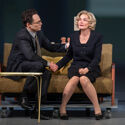

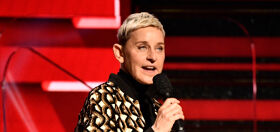


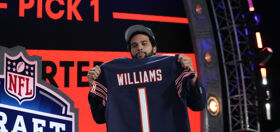

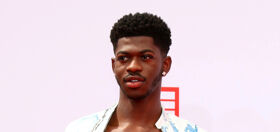

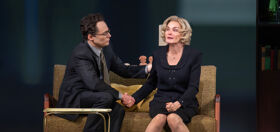


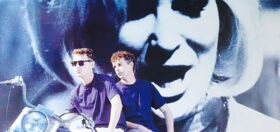

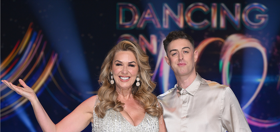
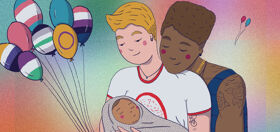


Pablo
In Albo’s defense he writes a lot of tongue in cheek and snarky pieces for other magazines. I don’t believe he wrote it to honor the A-gay. He wrote a hysterical piece about The Grove mall in the NY TIMES recently.
Joe Moag
I can only speak for myself when I say that I do not have a fucking clue as to what 99 percent of the references are in these quotes. I don’t know whether to be offended, proud, bored, amused, or just plain confused.
I’ll go with confused, while I attempt to google all the crap that these guys are talking about to figure out the degree to which I should be insulted, which I am sure is a pretty fairly high degree.
UW Student
I remember reading this article and being disgusted. Apparently if I’m not an A or a B gay I am destined to be a waiter at Applebee’s. How about the gay American who want to be an English teacher…where does that fit on your fucking scale of fags. I’m going to get married, have a family, and make less money than I should. But I’m sure as hell going to be happy living without a label. Consider my subscription canceled.
Lukas
I feel like the A-gay is more about class than sexuality.
ggreen
A-gays don’t know that there is anyone else in the world but them. I have a cuter name for them B-queens. I have been and have known many over achieving gays. Usually it was caused by a desire to over compensate for some perceived deficiency but sometimes it is simply a desire for excellence. People without kids or a relationship often can give the kind of commitment to projects that people with kids and or a relationship can not.
seitan-on-a-stick
Would that be “hothouse flowers” as I thought you may have gone off on a baking tangent, Editor-in-Confusion? There seems to be three articles here:
First, the proclaimed Gay “A-List” who don’t mention who is one (which reeks of the Down-Lo syndrome media hit-job by Rolling Stone who some claim to be liberal bastions of thinking)
Second, the Editor(s) story on his racist Professor is a great opportunity to write about Reverse Racism (When Blacks are racist…) but instead just summarized the Professor as Out-of-his-depth after tongue-in-jowl praise.
Third, back to Stonewall West and we have not learnt anything new like where Proposition 8 stands now and the plans of the organizers.
For someone who went to NYU, you should have paid more attention in class and perhaps we would not have been subject to over-lapping agendas in this confusing screed.
No wonder many bloggers have left this site with these sloppy posts.
Distingué Traces
Various people have said that the satire must have been excised by his editors, given his usual stance.
But, yeah. Whether Albo is responsible or Details editors are, the article was beyond creepy and pathetic.
And I don’t know what they thought they were doing. I doubt that this sort of desperate begging for validation of gay masculinity can have been very attractive to straight readers, and of course to gay men it’s offensive. A very strange publishing decision.
John
@Lukas:
Of course. Everythings about ‘class, power or money’
John
@seitan-on-a-stick:
You’re a sweetheart!
Pete D
Relax your anal glands mate. This is a playful, satiric and very smart piece of social commentary. Perhaps what’s most stinging is the stark reality that we all live within a certain class system.. no matter what are status or orientation.
ML
Details tries waaaay too hard to be hip and ironic which is why I cancelled my subscription a few years ago. I’m not sure who their market is but I don’t know a single person who reads it.
Eminent Victorian
I don’t understand what this entry is really about. Or, maybe I do understand what this is really about and just don’t understand why it was published. If you want to write a blog all about yourself, by all means go ahead, but don’t let’s keep calling it Queerty. I’ve read enough entries that are about the current editor, his friends, his life, blah-dee-blah. I’m done.
bobito
Gee, I’ve never even been to a foam party in Mykonos or a bathhouse of the lower castes – or a bar called Rawhide. I guess that makes me, what, a E-gay?
Oh, well, at least I’m not an X-gay.
(PS – having a much-younger boyfriend isn’t even remotely creepy if you’re rich as fuck-all, it’s a standard accessory – akin to a lower-caste gay’s belt…)
shivadog
Details is for shallow “trendy” people who need someone to tell them what to think and what to wear. I find it very annoying. (for some reason they keep sending it to me even though I have never subscribed or paid them anything) The article makes me glad I’m more of a D-gay or F-gay.
St. Francis of a-sissy
Memo to straights:
Don’t try to “figure us out” or drop us into neat little categories. Just give us equal rights, then LEAVE US THE FUCK ALONE!!!
REBELComx
A-gay?
I think we have another word for this type of person already, whether they be gay or straight: SNOB.
ZeeLee
Ok, either the quotes in this chapter were made by a straight guy or he doesn’t know what FUCK he is talkingh about. I don’t know whether to be insulted or to laugh.
Distingué Traces
@Eminent Victorian:
I disagree. I like blogs that have a personal tone and a point of view rather than simply posting summaries of links.
We’ve seen the “my livejournal” approach taken a little far at Queerty in the past, but this entry was the editor’s own take on the public gay issues of the day, not just self-involved nattering.
Pragmatist
Wow. Those excerpts leave me seriously unimpressed. Not offended, just deeply underwhelmed. I don’t think I’ve read such a densely packed string of cliches and name-drops all year long!
Factually, I don’t think the core of Albo’s observation is that far off from the truth. It’s just not very interesting, either. Of course some members of the capitalist class are gay. (And as homo/bisexuality have become less taboo, I’d suspect there are more people in that category these days.) Of course people in different classes live differently. Is that news?
waffle twat
Albo jumped the shark a while back. His Underminer character was delightful in book form, but wore out its welcome when he tried to squeeze more mileage out of it in those god-awful posts he wrote for Gawker. And now this. It’s just lazy writing, for a paycheck, which is fine so long as nobody *cough cough Pete D. cough* mistakes it for actual satire. At least the handy chart Albo provides reaffirms our sense of community, since A, B, and C gays can apparently unify on one point: all of us love Madonna.
Joe Moag
@waffle twat: I guess that I must be a “D” list gay, as I cannot stand Madonna. 🙂
mark
The biggest point of this story is WE decide who ranks an A, B or C in our community, we don’t allow heterosexuals to decide which are the good gays and which are the bad gays.
joe
I understand Mike Albo’s article. In fact I was just commenting on the racial hierarchy in gay culture, however unregulated. Right now, there is such a large amorphous mass of gay men, almost amoeba-like, and a few have grown bones and stature and decided to prove worthiness than wordiness. You have to understand the parallels of the struggle for a clear identity just like American Blacks. Blacks will no longer tolerate the blackface characterization as subordinate and powerless. I’m not an American Black, but if I were, I’d certainly feel a new layer of growth and self-awareness after seeing Obama elected president. I’d look for strong leadership roles. Imagine how women look towards Oprah. A strong, rich, powerful yet vulnerable woman – something they can see in themselves. Having characters out there on TV to “help” others is what is wrong. We need leaders who are doing something, not chatting about it. C’mon, really, grow a sense of purpose and do something that contributes to everyone, not just gay people. That is the mark of a great person and until then, shut up.
Alexa
Bottom line, straights aren’t even going to attempt to stop stereotyping until we stop doing it ourselves, and stop making fun of other gays who don’t have perfect bodies or faces. Case in point – the first comment on today’s post about Clay Aiken and his boyfriend asks (jokingly) which one is the guy. How can we expect people to respect us if we don’t respect ourselves?
seitan-on-a-stick
Bobito; Rawhide is a T-list bar as in the clientele are strung out on Crystal-meth or looking to pay little down on a hustler. No A through F listers in sight. There is a water bowl for dogs outside which is thoughtful.
BTW – Who thought Details went out of circulation until this article?
chuck
@Alexa:
Isn’t interesting, that we (the gays) ALWAYS have to be the ones to stop doing something (sterotyping for example) that straights have been doing for ages, so that we might “set a better example” in order to grab the approval and acceptance of the str8s who are joking and making fun of us?
It’s kind of white folks telling black people to stop calling each other the “N” word, if they want whitey to “respect” them. As long as they are not calling us “honkey”, they can say anything they like amongst themselves, as far as I am concerned. It’s NOMFB.
And what we gays choose to say to each other, ss long as we are not calling str8s “breeders” or other demeaning names, is really NOYFB.
That horrible sound you hear in the background, is me barfing.
Chris
The weird thing is Mike Albo is gay. He writes a lot of gay-themed stuff. His piece was a bit ridiculous though.
brcksvg
Albo is a gay, however he’s kind of become notorious of recent for writing mildly offensive pieces for details about gays. Seeing as how he’s a pretty talented performance artist, I’m starting to wonder if it’s not all some big joke.
I have to admit, I’m a little lost as to the point of Albo’s article. But I’m also confused as to the point of Japhy’s anger. We all know castes exist in the gay community. And as someone who is probably considered Y-list, I can attest to how invisible we are to those of higher levels (including several instances with Mr. Albo himself)
Michael
Cripes! That was the most off-topic meandering lead-in I think I have ever read, but eventually you got to the story, didn’t ya?
Details is for closeted guys anyway. “I’m not gay! I’m urbane!”
BLECH!
Michael W.
Sounds like heaven.
Give me about 10 years after college and I hope to be on the A-list. I’ve got all the right ingredients.
Those among us who hate the hierarchy are the ones who will never reach the top. It’s like administrative assistants and sanitation workers lamenting CEO compensation.
nycmattman
The fact that all of you don’t see this funny writer has written a funny article is the funny part. Hee hee hee. Gallerists in Gstaad!!! He kills me!!!
Distingué Traces
@nycmattman:
Yeah, no one understands how hilarious I am either.
I tell people again and again that I’m a funny guy, but for some reason I can’t get the point across.
What’s wrong with everybody I talk to?
mark
Maybe this is generational, but I never heard of A-Gays does anyone say that?
it’s always been called A-queens in my life.
mark
is there a comparable lesbian term?
Roland Basque
The heavens were displeased with the sons of Arabia because of their proclivity towards homosexuality.The Arabs abuse women and beat them .They do not like women they only seek intimacy with other arab men.The practice of homosexuality was introduced to Arabia by Irish “wild geese”.The arabs took up this custom with great glee and even neglected their camels to bestow their affections on other Arabic males.Little is known about the original Irish practicioners of this custom other then they went on to the countries of England and Scotland for a lengthy sojourn.Now the Arabs perform puerile acts of violence to disguise their rampant homosexuality but without the desired results.The world is aware of the fact that homosexuality is a way of life in Arabia.
hardmannyc
wow, your parents paid $35,000 a year so you could sit through that crap?
Daniel
Mike Albo is a hilarious gay man. I know for a fact he has encountered more than just gays in frat houses. Do a search for “Critical Shopper” on the NY Times website, and you’ll see some more of his writing. It’s pretty damned funny.
One time I saw him do a Paris Hilton Sketch. He came out in a pink mini-skirt, with a thin pink belt covering his nipples and a single lock of long blond hair attached to his head of curly brown hair. It was the most biting and funny representation of Paris Hilton circa 2004 that I have ever seen.
DavidOnTheMedia
Bottom line, the food chain fantasy exists in all races and sexualities, no big deal, he just pointed out one area. Truth is, there is A B C D and F in all levels of society, in each of us, so I wouldn’t get too cluttered up with trying to define yourself through these forays. I can’t stand prime rib without the au jus. That about sums it up.
The only one I may attempt to call an A lister is someone who is just being themselves and lov’n life without the fear of defining who and what they are by someone else’s measuring tape. That very act is insecurity ala mode, on both parts.
The sexiest men have one thing in common, confidence.
So lax, and hope we get to see all areas of gay expression in the media, regardless if one may think they need to place themselves in a delusional food chain.
mark
Roland…the sixties were really good to you
paul
So here is a potential A Gay who has happily opted for D Gay status. I mean, whenever I have been with the likes Mike Albo describes in Details I have been bored out of my mind. Typically I have also been nauseated, dumbfounded and exasperated at all of the narcisscism and lack of depth and warmth.
Get real, aspiring to be an “A Gay” is a loser proposition. While I always encourage all to reach for the stars, this is not what being on top of the world looks like. A Gay as described here at least sounds very much like hell.
Jim
Ummm, yeah.
Writer- the joke’s kinda on you, man. I used to date Mike Albo. This is social satire. Quit being so serious and maybe choose your battles, huh?
jason30
Thanks Jim. Have any of you people ever heard of satire? Mike Albo is gay (sounds like from this posting the author didn’t realize this). And generally quite funny, both in his writing and live performance. All of you need to relax a bit and enjoy a laugh sometimes.
Geoffrey
“Some of us are exotic hothouse flowers and some of us are strudy pine trees”…what a great quote. Thank you for a great take on this Japhy.
screech
uh yeah…I think the writer was tone deaf to the irony in Mike Albo’s piece….
This is a lot of criticism for something that the writer doesn’t even really seem to “get”…
Bobster
Albo used to do porn. We can’t expect deep thoughts from him.
M Shane
These A gays are todays closet cases brought to you thanks to assimilationist idiots like Sullivan. Don’t be fooled most people who happen to luck out on the side of inhereted money and determine to fit in too straight society by ACTING straight are just a new closeted group promoted and made possible by the right wing neocons we all rightfully dispise. It not real, but a fantasy that some of these queens live out, eveentually less happily than you may think.
A-Lister
Those among us who hate the hierarchy are the ones who will never reach the top.
That’s not true.
Lots of us know it’s bullshit and all a con. It’s really easy to get to the top if you work hard and are smart.
There’s more competition for the 9 to 5 “easy predictable” jobs than for the ones at the top, which require 80 hour weeks, midnight conference calls, and constant travel.
Most people who bitch about the hierarchy are just too lazy or have other priorities.
Those at the top, on the other hand, often have meaningless lives characterized by wealth and an overinflated sense of self-importance.
Pick your poison, kids.
Alexa
@chuck:
How you got all that from my response is beyond me. Also interesting to note you apparently don’t regard lesbians as gay.
Mark Z
seitan-on-a-stick, there is no such thing as “reverse racism.” It’s just racism regardless of the intended target.
Fist Fight
this is not progressive. We as gays have a chance to create a new type of person, of character, of relationships yet we just continue to emulate the heterosexual culture we’ve been stifled by. The “A Gay” is a perfect example of this. It’s not acceptance it’s conformist.
bobito
Absolutely, FistFight – according to the article, which some commenters now inform us is a ‘satire’ (isn’t satire supposed to be funny? just asking) the A-Gay assimilates heterosexual culture to the extent that he shuns the lower-caste gays. It’s not so much about ‘class’ per se as it is about wealth and entitlement – Mary Cheney would qualify as an A-Gay by these standards, and frankly, I don’t see all that much to admire in her behaviour.